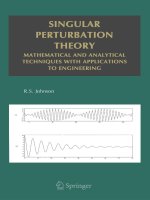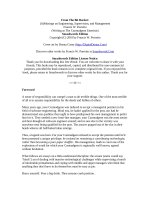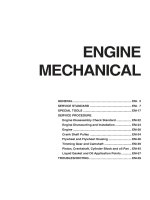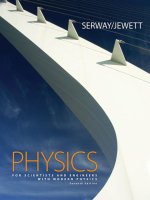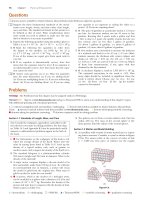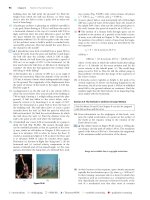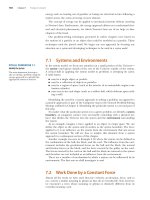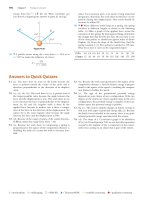Hyundai mighty w engine
Bạn đang xem bản rút gọn của tài liệu. Xem và tải ngay bản đầy đủ của tài liệu tại đây (576.81 KB, 38 trang )
Injection Pump
HYUNDAI MIGHTY W Engine
COMMON RAIL SYSTEM (CRS)
Operation Manual
June 2004
00400075E
© 2009 DENSO CORPORATION
All Rights Reserved. This book may not be reproduced
or copied, in whole or in part, without the written
permission of the publisher.
TABLE OF CONTENTS
1. DENSO PRODUCTS LIST . . . . . . . . . . . . . . . . . . . . . . . . . . . . . . . . . . . . . . . . . . . . . . . . . . . . . . . . . . . . . . . . . . . . . . . . . . 1
2. SYSTEM OUTLINE . . . . . . . . . . . . . . . . . . . . . . . . . . . . . . . . . . . . . . . . . . . . . . . . . . . . . . . . . . . . . . . . . . . . . . . . . . . . . . 2
3. COMPONENTS DESCRIPTION . . . . . . . . . . . . . . . . . . . . . . . . . . . . . . . . . . . . . . . . . . . . . . . . . . . . . . . . . . . . . . . . . . . . 5
4. DESCRIPTION OF CONTROL SYSTEM COMPONENTS . . . . . . . . . . . . . . . . . . . . . . . . . . . . . . . . . . . . . . . . . . . . . . . . 19
5. CONTROL TYPES . . . . . . . . . . . . . . . . . . . . . . . . . . . . . . . . . . . . . . . . . . . . . . . . . . . . . . . . . . . . . . . . . . . . . . . . . . . . . . . 26
6. DIAGNOSTIC TROUBLE CODES (DTC) . . . . . . . . . . . . . . . . . . . . . . . . . . . . . . . . . . . . . . . . . . . . . . . . . . . . . . . . . . . . . 32
1. DENSO PRODUCTS LIST
1-1. Vehicle Specifications
Name
Engine Type
Engine Displacement
MIGHTY
W
3.9 L
Reference
Compact trucks: 2 ton, 2.5 ton, 3 ton
1-2. Part Numbers
Part Name
DENSO Part Number
Customer Part Number
Reference
Supply Pump
294000-0290
33100-45700
Injector
095000-5550
33800-45700
Rail
095440-0600
31440-45700
Engine ECU
275800-3142
39100-45700
NE Sensor
029600-0570
39340-45700
Magnetic induction type
TDC Sensor (G Sensor)
949979-1450
39350-45700
Magneto
HP-3 type
resistance
type
Accelerator
Pedal
Position
-
-
Non-DENSO product
Coolant Temperature Sensor
-
-
Non-DENSO product
Manifold
-
-
Non-DENSO product
-
-
Non-DENSO product
Sensor
Absolute
Pressure
(MAP) Sensor
Intake Air Temperature Sensor
element
2.
SYSTEM OUTLINE
Focused on complying with exhaust gas regulations for diesel engines, the CRS was developed to achieve the following: 1)
a further reduction in fuel consumption, 2) improved quietness, and 3) higher output.
2-1. System Characteristics
The CRS uses a pressure accumulation chamber called a "rail" to store high-pressure fuel. This high-pressure fuel is
then injected into each engine cylinder from solenoid controlled injectors. Since the engine ECU controls the injection
system (injection pressure, injection rate, and injection timing), the CRS achieves independent control uninfluenced by
engine rotational speed or load. Therefore, stable injection pressures can be maintained, specifically in the engine low
rotational speed region. As a result, the black smoke inherent to diesel engines during take-off and acceleration is suppressed, exhaust gas is cleaner and reduced in quantity, and higher output is achieved.
A. Injection pressure control
High-pressure injection from the engine low rotational speed region.
Optimal control to minimize particulate, and NOx exhaust gas.
B. Injection timing control
More precise, optimal control suited to driving conditions.
C. Injection rate control
Pilot injection that delivers a very small injection prior to the main injection.
2-2. OUTLINE OF CONSTRUCTION AND OPERATION
A. Configuration
The primary CRS consists of a supply pump, rail, injectors, and engine ECU.
B. Operation
a.
Supply pump
The supply pump draws in fuel from the fuel tank, and delivers high-pressure fuel to the rail. The rail internal pressure is
controlled by the quantity of fuel discharged from the supply pump. The aforementioned control is performed by the Suction Control Valve (SCV) inside the supply pump based on signals from the engine ECU.
b.
Rail
The rail is positioned between the supply pump and injectors to store high-pressure fuel.
c.
Injectors
In place of the conventional injector nozzle, the injectors equipped with the CRS use signals from the engine ECU to
achieve optimal injection. The quantity, rate, and timing for the fuel discharged from the injectors is determined by signals
from the engine ECU. These signals control the length of time that the injectors are energized, as well as the timing for
injector energization.
d.
Engine ECU
The engine ECU calculates data detected from each sensor to provide overall control of items such as the following: fuel
injection quantity, fuel injection timing, injection pressure, and Exhaust Gas Recirculation (EGR.)
2-3. Fuel System and Control System
A. Fuel system
The fuel system starts from the fuel filter, and continues through the supply pump, and rail until the the diesel fuel is discharged from the injectors. The fuel system also includes the return path to the fuel tank via the overflow pipe.
B. Control system
In the control system, the engine ECU regulates fuel injection based on signals from each system sensor. The control
system can be divided by component type into three categories: 1) sensors, 2) the engine ECU, and 3) actuators.
a.
Sensors
Sensors convert engine and driving status into detectable electric signals.
b.
Engine ECU
The engine ECU performs calculations based on the electric signals from each sensor, then sends signals to each actuator to achieve the optimal system conditions.
c.
Actuators
The actuators operate based on electric signals received from the engine ECU. The fuel injection system controls the
actuators electrically. The injection quantity and injection timing are determined by how long the injector Two Way Valve
(TWV) is energized, while injection pressure is determined by controlling the Suction Control Valve (SCV) for the supply
pump.
3. COMPONENTS DESCRIPTION
3-1. Supply Pump (HP-3)
A. Outline
The HP3 supply pump primarily consists of the pump body (eccentric cam, ring cam, and plungers), SCV, fuel temperature sensor, and fuel pump.
Two plungers are mounted in vertical opposition on the outside of the ring cam, creating a compact assembly.
The supply pump is actuated in a 1:1 ratio in relation to the engine. The feed pump (trochoid type) is built into the supply
pump to draw fuel up from the fuel tank for delivery to the plunger chamber.
Fuel delivered to the plunger chamber is placed under high pressure by the two plungers (driven by the internal camshaft), then sent to the rail. The quantity and timing for the fuel supplied to the rail is controlled by SCV operation via
signals from the engine ECU. The SCV described herein is a normally open type (when not energized, the SCV is open.)
*1: Expanded View (Reference)
B. Fuel flow inside the supply pump
Fuel drawn from the fuel tank is sent to the rail from inside the supply pump through the path shown in the figure below.
C. Supply pump construction
An eccentric cam is attached to the supply pump drive shaft.
In turn, the eccentric cam fits into the ring cam.
When the drive shaft rotates, the eccentric cam turns "eccentrically". As a result, the ring cam moves up and down while
rotating.
Plungers and suction valves are attached to the top of the
ring cam. The feed pump is then attached to the end of the
drive shaft.
D. Supply pump operation
As shown in the figure below, the ring cam and plunger A are pushed upward by eccentric cam rotation. Conversely,
plunger B is pulled in the opposite direction of plunger A due to spring force. As a result, plunger B draws in fuel, while
plunger A sends fuel to the rail.
3-2. Explanation of Supply Pump Components
A. Feed pump
The feed pump is a trochoid type pump built into the supply pump. The feed pump draws fuel from the fuel tank, and
sends the fuel to the two plungers via the SCV. The feed pump is operated by the drive shaft. When the feed pump inner
rotor turns, an amount of fuel is drawn in from the suction side of the pump that is equivalent to the space (increasing or
decreasing in size) created between the outer and inner rotors. This fuel is then sent to the pump chamber from the discharge side of the feed pump.
B. Suction Control Valve (SCV)
The SCV is a linear solenoid type valve. The engine ECU controls the amount of time that the SCV is energized (duty
ratio). In turn, the SCV regulates the fuel flow volume supplied from the high-pressure plungers.
The SCV reduces the supply pump actuation load by drawing in only the quantity of fuel necessary to meet the target
rail pressure.
When electric current is sent through the SCV, the internal
needle valve moves in accordance with the duty ratio to control the fuel flow volume.
When the SCV is off, the needle valve is pressed down by the
return spring. As a result, the fuel path completely opens,
supplying fuel from the plungers (entire quantity suctioned,
entire quantity discharged.)
When the SCV is on, the return spring contracts, and the fuel
path closes.
When the SCV is cycled on and off, fuel is supplied in a quantity corresponding to the SCV open surface area(determined
by the actuation duty ratio). The fuel is then discharged from
the plungers.
a.
Short duty on time
large valve opening
When: short duty on time
large suction quantity
large valve opening
large suction quantity
b.
Long duty on time
small valve opening
When: long duty on time
small suction quantity
small valve opening
small suction quantity
c.
Relationship between actuation signals and current (magnetomotive force)
Diagram of the Relationship Between Actuation Signals and Current (Magnetomotive Force)
C. Attention points for supply pump removal and attachment (reference)
To preserve SCV (attached to the supply pump) performance accuracy, the engine ECU performs idle learning corrections. Be aware that when the supply pump is replaced, work must be done with a vehicle manufacturer tester (at a car
dealer) to match the learning value for the old SCV with the new SCV.
3-3. Rail
A. Outline
The rail stores high-pressure fuel delivered from the supply pump for distribution to the individual injector for each cylinder. A rail pressure sensor and pressure limiter are attached to the rail. The rail pressure sensor detects the pressure of
the fuel inside the rail, and sends a corresponding signal to the engine ECU. The engine ECU controls the supply pump
SCV based on this signal to regulate pressure inside the rail.
B. Rail pressure sensor
The rail pressure sensor detects fuel pressure within the rail, and sends a corresponding signal to the ECU. The rail pressure sensor is a Piezo resistance type semiconductor pressure sensor. The sensor uses the pressure added to a metal
diaphragm, and the accompanying changes in electrical resistance to detect pressure inside the rail.
C. Pressure limiter
The pressure limiter is a valve that opens to release excess pressure when the rail internal pressure reaches an abnormally high value. When rail internal pressure reaches approximately 221 MPa, the pressure limiter opens. When pressure returns to approximately 50 MPa, the pressure limiter closes. Fuel released from the pressure limiter is returned to
the fuel tank.
D. Flow damper
The flow damper mitigates pressure pulsations in the rail, and functions to supply fuel when leaks occur downstream of
the damper. When pressure pulsations occur in the rail, the flow damper piston acts as a damper to mitigate the pulsations with spring drag and orifice flow resistance. When a fuel leak occurs in an injection pipe or injector, the balance
between the following three forces is disturbed: 1) the pressure of the fuel being supplied via the orifice downstream of
the flow damper, 2) spring drag, and 3) the fuel pressure being applied to the piston surface prior to the orifice. As a
result, the end of the piston closes the fuel supply port to terminate the supply of fuel. When rail internal pressure reaches
approximately 1 MPa (10 kg/cm2), the fuel damper recovers.
3-4. Injectors
A. Outline
The CRS uses compact, energy efficient, TWV electromagnetic control type injectors.
B. Construction
C. Operation
The TWV regulates control chamber internal pressure, and starts and stops injection by opening and closing the outlet
orifice path.
a.
Non-injection
When no current is supplied to the solenoid, the TWV is pushed downward by the spring, and the outlet orifice closes.
Therefore, the control chamber pressure pushing down on the command piston becomes equal to the pressure pushing
the nozzle needle up. The nozzle needle closes due to nozzle spring force, and the difference in areas to which pressure
is being applied, and as a result, fuel is not injected.
b.
Injection
When current is initially applied to the solenoid, the attraction of the solenoid pulls the TWV up, opening the outlet orifice
and allowing fuel to flow out of the control chamber. As the fuel flows out, control chamber pressure decreases, pulling
the command piston up. As a result, the nozzle needle rises, and injection begins.
c.
Injection complete
When current continues to be applied to the solenoid, the nozzle is lifted fully, and the maximum injection rate is
achieved. When current to the solenoid is turned off, the TWV falls and closes the orifice. Fuel then flows into the control
chamber via the inlet orifice, increasing the pressure. As a result, the nozzle needle rapidly closes, and injection stops.
D. Injectors with QR codes
a.
QR codes
QR Code Location
Correction Points Using QR Codes
